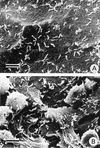Pathogenicity of Vibrio alginolyticus for cultured gilt-head sea bream (Sparus aurata L.)
- PMID: 9797276
- PMCID: PMC106638
- DOI: 10.1128/AEM.64.11.4269-4275.1998
Pathogenicity of Vibrio alginolyticus for cultured gilt-head sea bream (Sparus aurata L.)
Abstract
The in vivo and in vitro pathogenic activities of whole cells and extracellular products of Vibrio alginolyticus for cultured gilt-head sea bream were evaluated. The 50% lethal doses ranged from 5.4 x 10(4) to 1.0 x 10(6) CFU/g of body weight. The strains examined had the ability to adhere to skin, gill, and intestinal mucus of sea bream and to cultured cells of a chinook salmon embryo cell line. In addition, the in vitro ability of V. alginolyticus to adhere to mucus and skin cells of sea bream was demonstrated by scanning electron microscopy. The biological activities of extracellular products of V. alginolyticus were hydrolytic activities; the products were able to degrade sea bream mucus. V. alginolyticus was cytotoxic for fish cell lines and lethal for sea bream. Moreover, the extracellular products could degrade sea bream tissues. However, experiments performed with the bath immersion inoculation technique demonstrated that V. alginolyticus should be considered a pathogen for sea bream only when the mucus layer is removed and the skin is damaged.
Figures


References
-
- Austin B, Stobie M, Robertson A W, Glass H G, Stark J R. Vibrio alginolyticus: the cause of gill disease leading to progressive low-level mortalities among juvenile turbot, Scophthalmus maximus L., in a Scottish aquarium. J Fish Dis. 1993;16:277–280.
-
- Balebona M C, Moriñigo M A, Faris A, Krovacek K, Månsson I, Bordas M A, Borrego J J. Influence of salinity and pH on the adhesion of pathogenic Vibrio species to Sparus aurata skin mucus. Aquaculture. 1995;132:113–120.
-
- Balebona M C, Moriñigo M A, Borrego J J. Role of extracellular products in the pathogenicity of Vibrio strains on cultured gilt-head seabream (Sparus aurata) Microbiol SEM. 1995;11:439–446. - PubMed
-
- Balebona, M. C., I. Zorrilla, M. A. Moriñigo, and J. J. Borrego. Survey of bacterial pathologies affecting farmed gilt-head sea bream (Sparus aurata L.) in southwestern Spain from 1990 to 1996. Aquaculture, in press.
MeSH terms
Substances
LinkOut - more resources
Full Text Sources
Molecular Biology Databases

